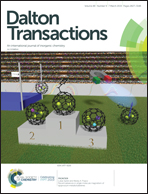Copper(ii) self-assembled clusters of bis((pyridin-2-yl)-1,2,4-triazol-3-yl)alkanes. Unusual rearrangement of ligands under reaction conditions†
Abstract
The reaction of two structurally related bridging ligands bis[5-(2-pyridyl)-1,2,4-triazole-3-yl]methane (H2L1) and bis[5-(2-pyridyl)-1,2,4-triazole-3-yl]ethane (H2L2) with copper(II) salts resulted in a surprising wide variety of complex structures [Cu2(H2L1)Cl2]Cl2·4CH3OH (1), [Cu4(L1)4]·4H2O (2), [Cu(H2L2)(ClO4)2] (3) and [Cu3(OH)Na2(L′)6](ClO4)·5H2O·C3H6O (4), where HL′ is 3,5-bis-(pyridin-2-yl)-1,2,4-triazole, which were structurally characterized by the X-ray diffraction method. Complexes 1 and 2 were prepared on the H2L1 basis and have binuclear and tetranuclear structures, respectively, demonstrating strong impact of the type of counter anion on the coordination mode of the ligand. In contrast, the reaction between Cu(ClO4)2 6H2O and H2L2 led to the preparation of mononuclear complex 3. The reaction of H2L2 with Cu(ClO4)2 under alkaline conditions led to oxidative rearrangement of the ligand and the homoleptic pentanuclear complex 4 with anionic ligand L′ was prepared. Magnetic properties were studied for compounds 1, 2 and 4 and for all of them the antiferromagnetic interactions between the Cu atoms were confirmed and analyzed by the spin Hamiltonian formalism. Furthermore, the occurrence of the antisymmetric exchange was confirmed in 4. The magnetic data analysis was supported by the X-band EPR measurements performed for complexes 1, 2 and 4.



 Please wait while we load your content...
Please wait while we load your content...